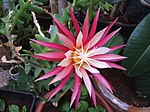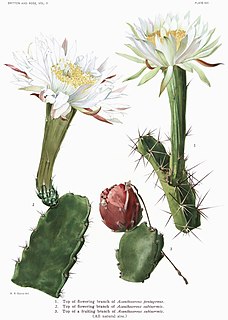
Acanthocereus is a genus of cacti. Its species take the form of shrubs with arching or climbing stems up to several meters in height. The generic name is derived from the Greek word άκανθα (acantha), meaning spine, and the Latin word cereus, meaning candle. The genus is native to the mostly tropical Americas from Texas and the southern tip of Florida to the northern part of South America, including islands of the Caribbean.
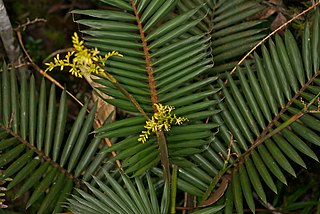
Calamus is a genus of flowering plants in the palm family Arecaceae that are among several genera known as rattan palms. There are an estimated 400 species in this genus, all native to tropical and subtropical Asia, Africa, and Australia. They are mostly leaf-climbing lianas with slender, reedy stems. To aid scrambling some species have evolved hooks on the underside of the midrib, or more commonly by modified "pinnae" or tendrils in the form of stout, backward-pointing spines. These stems may grow to lengths of 200 metres.

Echinopsis is a large genus of cacti native to South America, sometimes known as hedgehog cactus, sea-urchin cactus or Easter lily cactus. One small species, E. chamaecereus, is known as the peanut cactus. The 128 species range from large and treelike types to small globose cacti. The name derives from echinos hedgehog or sea urchin, and opsis appearance, a reference to these plants' dense coverings of spines.

Echinocactus is a genus of cacti in the subfamily Cactoideae. The generic name derives from the Ancient Greek εχινος (echinos), meaning "spiny," and cactus. It and Ferocactus are the two genera of barrel cactus. Members of the genus usually have heavy spination and relatively small flowers. The fruits are copiously woolly, and this is one major distinction between Echinocactus and Ferocactus. Propagation is by seed.

Echinocereus is a genus of ribbed, usually small to medium-sized, cylindrical cacti, comprising about 70 species native to the southern United States and Mexico in very sunny, rocky places. Usually the flowers are large and the fruit edible.

Melocactus, also known as the Turk's cap cactus, is a genus of cactus with about 30–40 species. They are native to the Caribbean, western Mexico through Central America to northern South America, with some species along the Andes down to southern Peru, and a concentration of species in northeastern Brazil.

In 1984, the International Organization for Succulent Plant Study set up a working party, now called the International Cactaceae Systematics Group, to produce a consensus classification of the cactus family, down to the level of genus. Their classification has been used as the basis for systems published since the mid-1990s. Treatments in the 21st century have generally divided the family into around 125–130 genera and 1,400–1,500 species, which are then arranged in a number of tribes and subfamilies. However, subsequent molecular phylogenetic studies have shown that a very high proportion of the higher taxa are not monophyletic, i.e. they do not contain all of the descendants of a common ancestor. As of March 2017, the internal classification of the family Cactaceae remained uncertain and subject to change. A classification incorporating many of the insights from the molecular studies was produced by Nyffeler and Eggli in 2010.

Disocactus is a genus of epiphytic cacti in the tribe Hylocereeae found in Central America, the Caribbean and northern South America. It should not be confused with Discocactus, which is a different genus.
Hylocereus is a former genus of epiphytic cacti, often referred to as night-blooming cactus. Several species previously placed in the genus have large edible fruits, which are known as pitayas, pitahayas or dragonfruits. In 2017, a molecular phylogenetic study in 2017 confirmed an earlier finding that the genus Hylocereus was nested within Selenicereus, so all the species of Hylocereus were transferred to Selenicereus.

Lepismium is a genus of mostly epiphytic cacti, with a dozen species. They are found in tropical South America.

Selenicereus undatus, the white-fleshed pitahaya, is a species of Cactaceae and is the most cultivated species in the genus. It is used both as an ornamental vine and as a fruit crop - the pitahaya or dragon fruit. The native origin of the species has never been resolved.

Selenicereus costaricensis or Hylocereus costaricensis, known as the Costa Rican pitahaya or Costa Rica nightblooming cactus, is a cactus species native to Costa Rica and Nicaragua. The species is grown commercially for its fruit, called pitaya or pitahaya, but is also an impressive ornamental vine with huge flowers. Its scientific name is problematic for several reasons. The species may not be distinct from Selenicereus monacanthus.
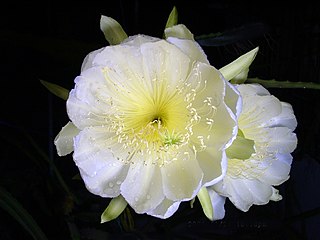
Selenicereus megalanthus, synonym Hylocereus megalanthus, is a cactus species in the genus Selenicereus that is native to northern South America, where it is known, along with its fruit, by the name of pitahaya. The species is grown commercially for its yellow fruit, but is also an impressive ornamental climbing vine with perhaps the largest flowers of all cacti.

Selenicereus setaceus, synonym Hylocereus setaceus, is a species of plant in the family Cactaceae. It is found in Argentina, Bolivia, Brazil, and Paraguay. Its natural habitats are subtropical or tropical dry forests, subtropical or tropical moist lowland forests, rocky shores, and sandy shores. It is not considered threatened by the IUCN.

Strophocactus brasiliensis, synonym Pseudoacanthocereus brasiliensis, is a species of plant in the family Cactaceae. It is endemic to Brazil. Its natural habitats are subtropical or tropical dry forests and hot deserts. It is threatened by habitat loss.
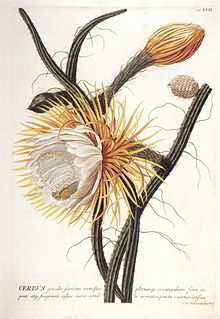
Selenicereus grandiflorus is a cactus species originating from the Antilles, Mexico and Central America. The species is commonly referred to as queen of the night, night-blooming cereus, large-flowered cactus, sweet-scented cactus or vanilla cactus. The true species is extremely rare in cultivation. Most of the plants under this name belong to other species or hybrids. It is often confused with the genus Epiphyllum.

The Hylocereeae are a tribe of cacti. Most are found in the tropical forests of Central and northern South America, and are climbers or epiphytes, unlike most cacti. The tribe includes between six and eight genera in different circumscriptions. The plants known as "epiphyllum hybrids" or "epiphyllums", widely grown for their flowers, are hybrids of species within this tribe, particularly Disocactus, Pseudorhipsalis and Selenicereus, less often Epiphyllum, in spite of the common name.

Selenicereus monacanthus, synonym Hylocereus monacanthus, is a species of plant in the family Cactaceae. It is native to parts of Central America and South America.
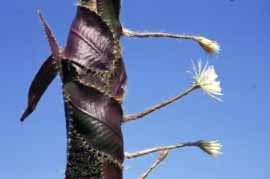
Strophocactus wittii, synonym Selenicereus wittii, known as the Amazon moonflower, is a species of plant in the genus Strophocactus in the cactus family (Cactaceae), and is one of several species commonly called "moonflowers". It was first described in 1900 and is one of three species of cactus found in the central Amazon basin.

Kimnachia is a monotypic genus of cacti. Its only species is Kimnachia ramulosa, synonym Pseudorhipsalis ramulosa, which is native from southern Mexico to northern South America and also found in Jamaica.

